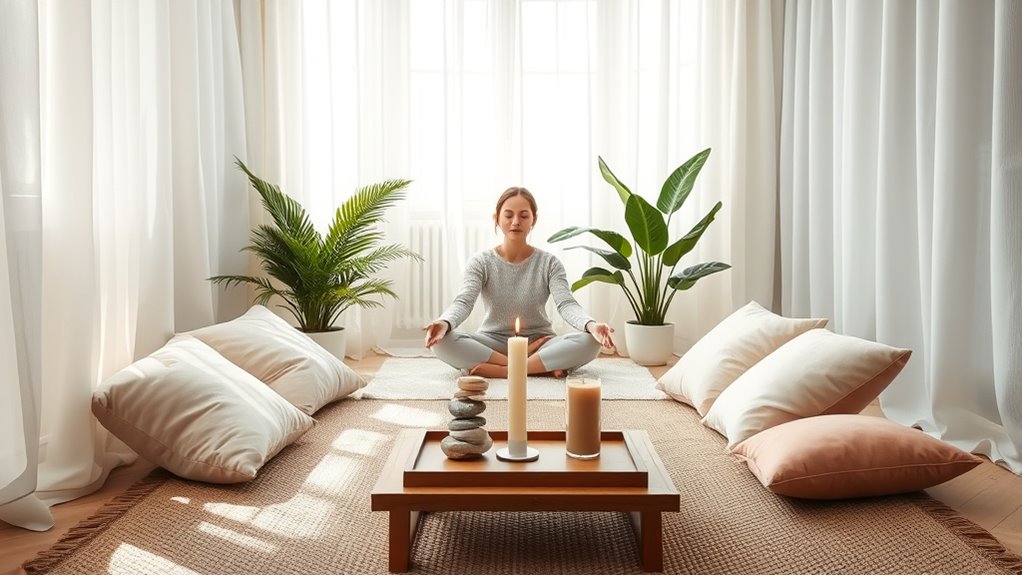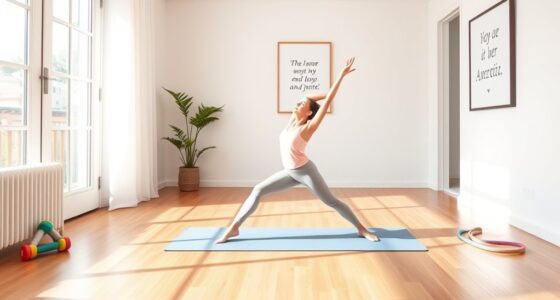Starting your meditation and mindfulness journey is simple. Focus on your breath, sit comfortably, and practice for just a few minutes daily. Remember, you don’t need to clear your mind completely or find a perfect space — it’s about observing thoughts without judgment. Incorporate mindful moments into routines and create a cozy spot for practice. Keep consistent, and you’ll discover more ways to enhance your mental clarity and reduce stress along the way.
Key Takeaways
- Start with simple breathing exercises and short daily sessions to build consistency and foundational skills.
- Understand that meditation involves observing thoughts without judgment, not clearing the mind entirely.
- Create a comfortable, quiet space with minimal clutter and calming elements to enhance your practice.
- Incorporate mindfulness into daily activities like eating, walking, or breathing during busy moments.
- Remember that flexibility and patience are key; no perfect postures or long sessions are necessary for beginners.
Understanding the Basics of Meditation and Mindfulness
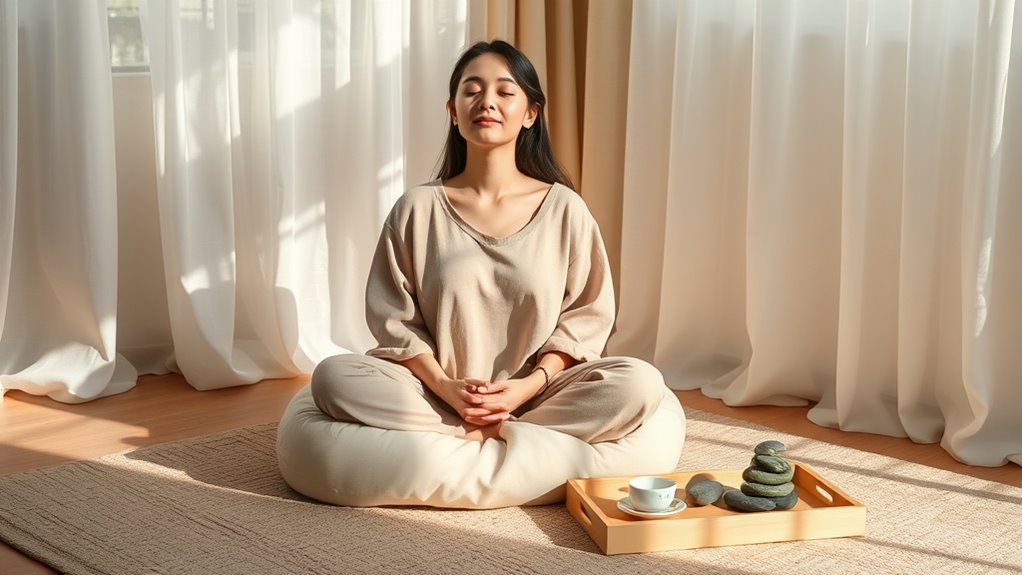
Understanding the basics of meditation and mindfulness is essential before you begin practicing. At its core, meditation involves focusing your attention, often on your breath, to promote relaxation and awareness. Breathing techniques are fundamental—they help anchor your mind and reduce distractions. As you practice, you’ll notice increased mental clarity, making it easier to stay present and manage stress. Mindfulness emphasizes paying attention to your thoughts, feelings, and sensations without judgment, encouraging a calm, centered state of mind. Starting with simple breathing exercises can markedly improve your focus and emotional balance. Remember, consistency matters more than duration. With regular practice, you’ll develop a deeper understanding of your mind and body, setting a solid foundation for advanced meditation techniques.
Common Myths About Meditation That Hold You Back
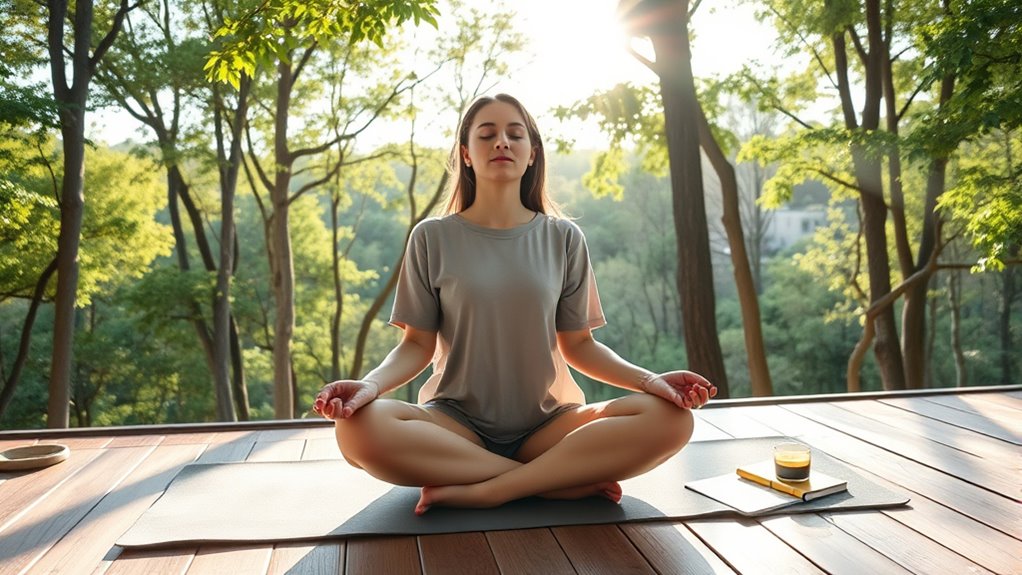
Many people avoid meditation because they believe they need to clear their minds completely or sit perfectly still for hours, but these are common myths that can hold you back. These meditation misconceptions make beginners feel discouraged or overwhelmed. In reality, mindfulness myths often suggest you must be perfect at meditation to benefit, which isn’t true. Meditation is about observing thoughts without judgment, not eliminating them. You don’t need to sit cross-legged for hours or block out every distraction. These false beliefs can prevent you from starting or maintaining a practice. Understanding that meditation is flexible and accessible helps you overcome these barriers. Recognizing that meditation can be adapted to your needs and preferences promotes mindfulness and presence, making it more approachable. Also, the idea that meditation requires special equipment or a quiet, distraction-free environment is another myth that can discourage beginners. Let go of these myths, and you’ll find meditation easier and more rewarding than you thought.
Simple Techniques to Start Your Practice
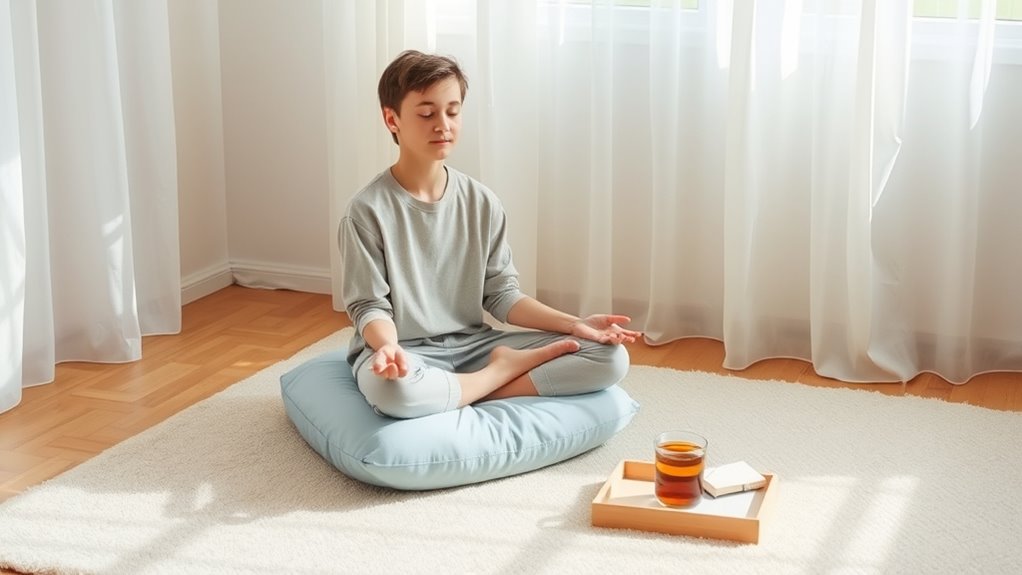
Starting your meditation practice doesn’t require complicated techniques or hours of commitment. You can begin simply with breathing exercises and comfortable seated postures. Focus on your breath, inhaling and exhaling slowly to ground yourself. Find a seated posture that feels stable and relaxed—sit with your back straight but not stiff. Here’s a quick guide:
| Technique | Benefit |
|---|---|
| Breathing exercises | Calms your mind and reduces stress |
| Seated postures | Promotes comfort and focus |
| Mindful breathing | Enhances awareness |
| Short sessions | Builds consistency effortlessly |
Start small, even five minutes a day, and gradually increase your practice. Incorporating mindfulness into your daily routine can further enhance your overall well-being. Developing a consistent routine can also help you build a sustainable habit that supports your mental health over time. Additionally, understanding Kia Tuning can inspire a sense of personal achievement and motivation in other areas of your life.
Creating a Comfortable Space for Meditation
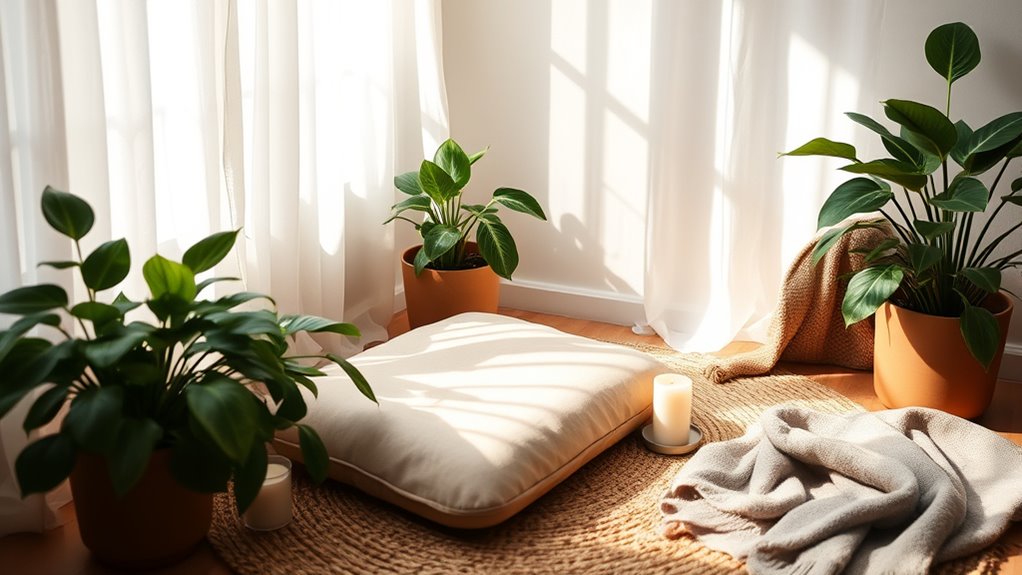
Creating a comfortable space for meditation is essential because it helps you establish a calm and focused environment. Start by paying attention to your decorating ambiance—use soft lighting, calming colors, and minimal clutter to create a serene atmosphere. Choosing cushions that support your posture is equally important; opt for ones that are comfortable yet provide proper alignment. Position your meditation space in a quiet area where interruptions are rare. Keep it simple and inviting, adding personal touches like a plant or a candle if it helps you relax. The goal is to make your space inviting enough to look forward to, so you can easily settle into your practice without distractions. Incorporating a clutter-free environment further promotes mental clarity and relaxation during your practice. Using ergonomic cushions can enhance comfort and support proper posture, making your meditation sessions more effective. Additionally, incorporating vibrational alignment techniques can help deepen your relaxation and improve your overall meditation experience. Establishing a consistent routine and mindful breathing in your space can also enhance your focus and tranquility. Creating a dedicated meditation area can help condition your mind to associate that space specifically with relaxation and mindfulness.
Incorporating Mindfulness Into Daily Activities
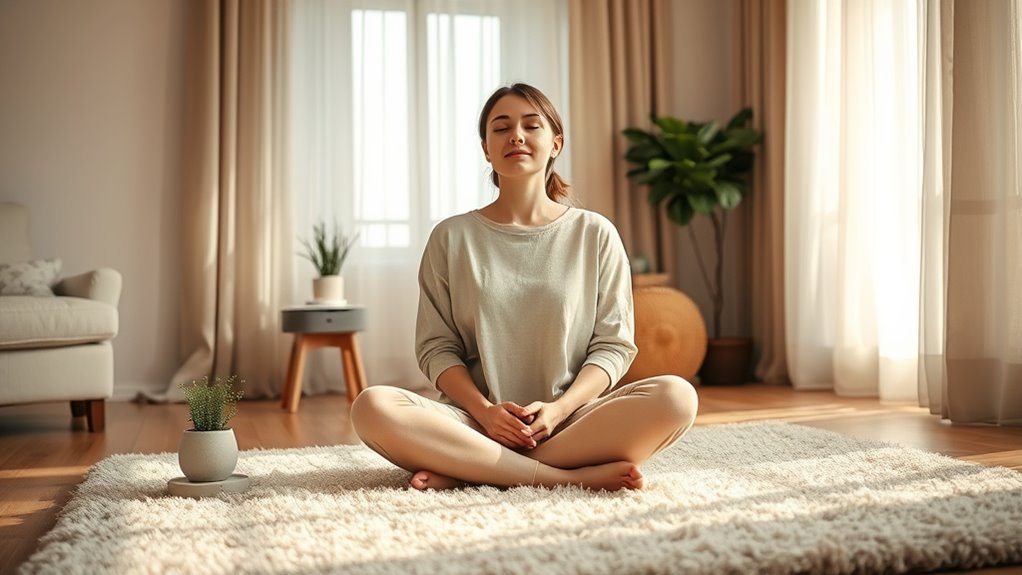
Once you’ve set up a peaceful space for meditation, you can expand that calm into your everyday routines by practicing mindfulness throughout your day. Start with simple breathing exercises, taking slow, deep breaths to center yourself during busy moments. Pay attention to your breath, noticing its rhythm and sensation. Incorporate mindful eating into meals by savoring each bite, focusing on the taste, texture, and aroma of your food. Avoid distractions like screens or multitasking while eating. Throughout the day, pause occasionally to check in with yourself, taking a moment to breathe deeply and reconnect with the present. These small practices help you stay grounded, reduce stress, and bring a sense of calm to even the busiest parts of your routine.
Tips for Staying Consistent and Overcoming Challenges
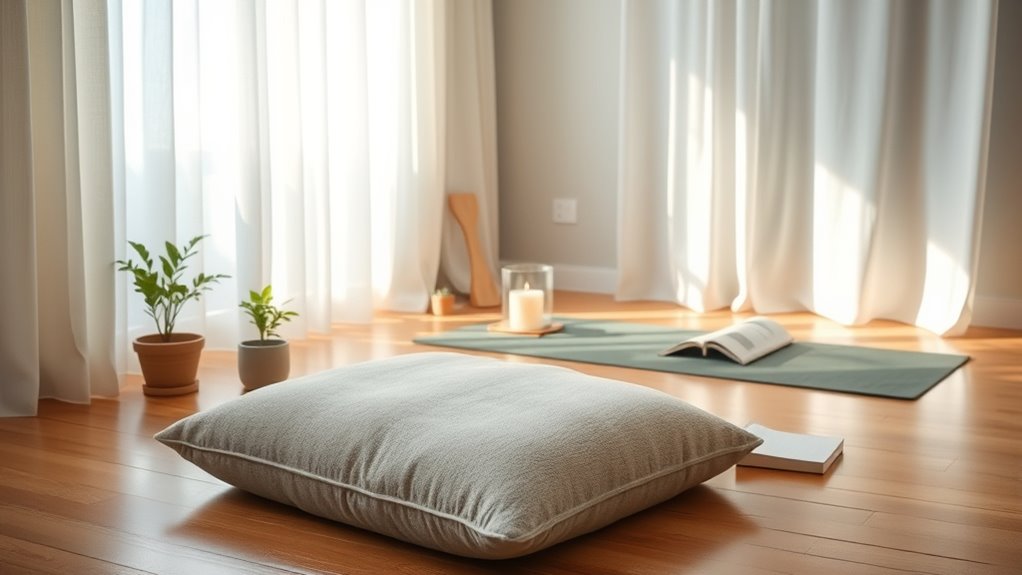
Maintaining a consistent meditation practice can be challenging, but staying committed is essential for experiencing lasting benefits. To build this habit, focus on habit formation by setting a specific time each day to meditate, making it part of your routine. Use reminders or cues, like placing your meditation cushion in a visible spot, to reinforce consistency. Additionally, accountability partners can boost your motivation—check in with a friend or join a meditation group to stay on track. When obstacles arise, remind yourself of the benefits and be flexible—shorter sessions are better than skipping altogether. Celebrate small wins to reinforce your new habit. Over time, these strategies help you overcome challenges, making meditation a natural, sustainable part of your daily life.
Frequently Asked Questions
Can Meditation Help With Severe Anxiety or Depression?
Meditation can considerably aid with severe anxiety or depression by supporting your mental health and enhancing emotional regulation. You might notice reduced stress and better control over overwhelming feelings as you practice regularly. While it’s not a cure, meditation offers a powerful tool to manage symptoms and foster a calmer, more balanced state of mind. Incorporate it into your routine to help improve your overall emotional well-being and resilience.
How Long Should I Meditate as a Beginner?
Imagine planting a tiny seed; you don’t need to water it all at once. As a beginner, start with just 5 to 10 minutes of meditation daily. This short duration helps you build a steady habit. Follow beginner meditation tips by gradually increasing your meditation duration as you become more comfortable. Consistency is key, so focus on creating a calming routine that fits your schedule and nurtures your mind.
Is It Necessary to Meditate in Silence?
You don’t have to meditate in silence; the environment depends on what helps you focus. Silent meditation creates a quiet space, but guided sessions can be more effective if you prefer direction. Some find silence calming, while others benefit from auditory cues. Experiment with both to see which suits you best. Ultimately, your meditation environment should foster comfort and concentration, whether that’s silent or guided.
Are There Specific Times of Day Best for Meditation?
Think of meditation timing as planting seeds at just the right moment. You can meditate morning, noon, or night—whatever fits your daily routine best. Consistency matters most, so choose a time when you’re least likely to be interrupted and can focus fully. Whether it’s sunrise or bedtime, integrating meditation into your daily routine helps cultivate calm and clarity, turning mindful moments into a natural part of your day.
Can Children Practice Meditation Effectively?
You might wonder if children can practice meditation effectively. The answer is yes, with proper guidance, children can benefit from meditation for kids. Child mindfulness helps them manage emotions and improve focus. Keep sessions short and engaging, using simple breathing exercises or guided imagery. Encouraging regular practice helps children develop healthy habits early, making meditation a valuable tool for their emotional and mental well-being.
Conclusion
As you settle into your daily practice, imagine a calm lake at dawn, its surface smooth and reflective. Each mindful moment is like a gentle ripple, spreading peace through your day. With patience and consistency, your meditation space becomes a sanctuary, your thoughts clear as a cloudless sky. Embrace this journey, and let mindfulness be the steady breeze guiding you toward serenity and inner balance. Your peaceful oasis awaits—just take the first step.

